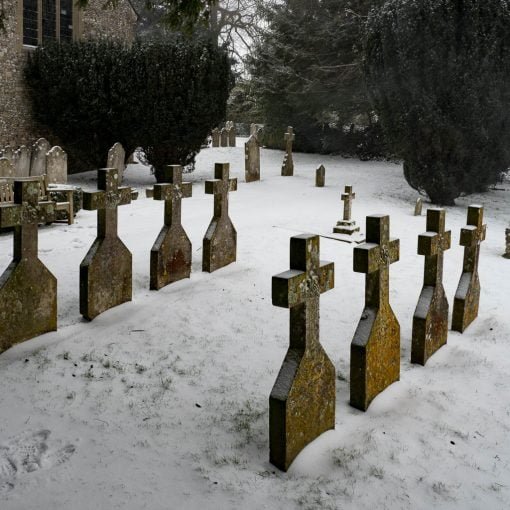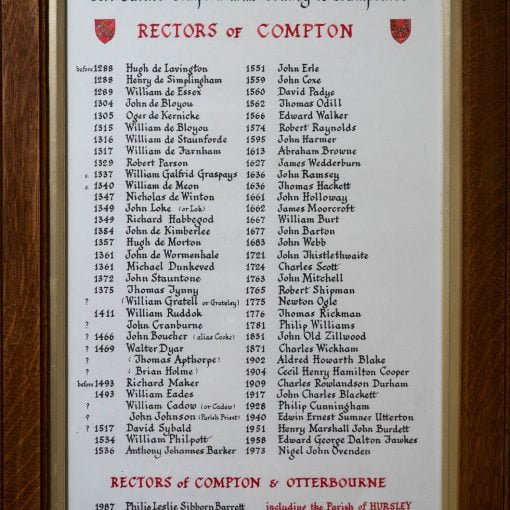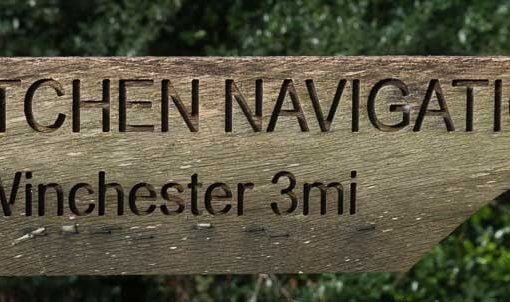Table of Contents
The Wayside Cross – 101 years on
- 1918 fund-raising leaflet describing the proposal for a Wayside Cross
- Invitation to the Wayside Cross Dedication Service on 24 April 1918
- Contemporary postcard of the Wayside Cross on its original mound. The Inscription reads: “To the glory of God, and in proud and grateful remembrance of the troops who passed this way in the early days of the great war, 1914–19.. to fight for the triumph of right and freedom.” Hampshire Records Office 191A09W/A12-7
- The Wayside Cross in April 2014 after it had been cleaned and treated, and the tablet after its cleaning and with its lettering repainted
- The Wayside Cross from the West, showing the millstone in which is it mounted.
Editor’s note: this is an expanded version of an article which appeared in the April 2019 issue of Compton & Shawford Parish Magazine.
In 1918, on Wednesday 24 April, more than six months before the end of hostilities, the rector, Rev J.C.Blackett, led the service of dedication for the newly erected Wayside Cross.
For once, J.S.Drew’s masterly account of our history, “Compton, Near Winchester” gets it wrong. It states that “the Wayside Cross was erected after the War”.
Drew may not have had access to the documents which are now available in the Hampshire Archives. And it is easy to assume that, since the stone tablet mentions “The Great War 1914-1919”, the Cross must have been erected after that date.
But, well before the end of the First World War, local people had started thinking about a roadside cross to commemorate the troops who had marched through our parish on their way to the trenches.
Letters to Mrs. Hallifax from architect Herbert Kitchin, of Compton End, dated 22 December 1917 and 1 January 1918, show that he had prepared two designs: a plain cross and a (£2 more expensive) cross with a circle. He added that
“I am glad to say that I have found a beautiful old millstone which would be the very thing for the base. It is made up of pieces of stone dowelled and dovetailed together … and will be practically indestructible. …
Perhaps it might be possible to vest the care of it in the Parish Council.
I will gladly subscribe to it.”
After selecting the simpler design, the committee’s next step was to raise money. The beautifully printed notice reproduced here attracted over 150 donations.
Quite Interesting:
- Permission was given by the Ecclesiastical Commissioners, owners of Shawford Down, and by Mr. Godwin, who leased the Down from them.
- At the dedication, no-one knew for sure when the war would end, so the inscription on the original tablet was just “1914-19..”, leaving the last two digits to be added later.
- Mr. G. R. Crawford of Avonmore, mentioned on the flyer, spoke at the dedication service. He went on to found the Compton & Shawford Festival Choir. He was its conductor from 1922-1939. He also chaired the meeting in 1936 which established the Heathcote Players in honour of Arthur Heathcote.
Next time you’re passing the Wayside Cross, take time to admire Herbert Kitchin’s design and the millstone base.
Where did they get the idea?
Possibly from the Wayside Cross Society.
An item in the Berkswich Parish Council newsletter for Spring 2017 website reports that
From 1917, the [Wayside Cross] Society campaigned for more crosses on roadsides, mirroring crosses in Belgium and France, which so impressed the British troops.
But goes on to say that
The Wayside Cross Society was disbanded in 1919 due to lack of public support.
In an article on British Catholics and the Great War by Fr. Nicholas Schofield, the Catholic website Faith gives a different reason for the closure of the Wayside Cross Society.
there was even a short-lived British organisation called the Wayside Cross Society, aiming to promote their erection both as memorials and places of prayer. Unfortunately, it was closed down in 1919 since such crucifixes were still deemed too ‘popish’ for the English.
Be that as it may, the Wayside Cross Society was active at the time Compton & Shawford were planning for their own wayside cross. The Winchester Diocesan Chronicle had printed an article about Wayside Crosses which mentioned the Wayside Cross Society. Our parish appears to have reprinted the article, possibly for distribution with the fund-raising leaflet. Its text is reproduced below.
ADRIAN WALMSLEY
Contemporary documents
With thanks to Hampshire Records Office item reference 1M76/PP1, we are able to reproduce several contemporary documents about the cross, its design and dedication.
- The fund-raising proposal leaflet
- The announcement of the Service of Dedication on 24 April 1918
- The text of a leaflet circulated to parishioners with a report of the Dedication Service.
- The text of an article, reprinted by the parish, about Wayside Crosses. Date presumed to be 1917 or 1918.
Proposal to Erect a Wayside Cross,
IN MEMORY OF THE TROOPS WHO PASSED THROUGH COMPTON AND SHAWFORD IN 1914.
In the early days of the War a considerable number of Men of the First Expeditionary Force passed along the Southampton Road on their way to France. We know now that it was by their heroic defence that England was saved, and in gratitude to them for all that they did for us and for our country, and in order that our children may be reminded of what they will know only by hearsay, it is proposed to erect a Wayside Cross on the mound between the Chalk Pit and the Main Road, overlooking the spot where many of the men rested. At the foot of the mound there will be a Stone Tablet with the following inscription :—
“TO THE GLORY OF GOD,
and in proud and grateful remembrance of the
troops who passed this way in the early days of
the great war, 1914 –
to fight for the triumph of right and freedom.”
It is not intended that this proposal should be considered as competing in any way with proposals for a Parish Memorial, in honour of those from this Parish who have fallen in the War, or for any County or National Memorial. It will merely represent the desire felt by a good many inhabitants that such an historical occasion should be fitly commemorated. Such Wayside Memorials were once common in this country, and it is known that many of our Soldiers have been deeply impressed by those which they have seen in France.
The Ecclesiastical Commissioners have granted their sanction for the use of the proposed site, and have expressed their approval of the scheme.
This notice is being circulated among the inhabitants of Compton and Shawford in order that all who care to be associated with the erection of the Memorial may have the opportunity of subscribing. Contributions, varying from 1d to £5, may be sent to any one of the following :—
- MRS. HALLIFAX, Kingsland House.
- MRS. MACKAY, Shawford Close.
- R. M. PAUL, ESQ., Southleigh.
- G. R. CRAWFORD, ESQ., Avonmore.
The Amounts of individual subscriptions will not be published.
A design of the Memorial has been drawn by Mr. G. H. Kitchin, and can be seen by Subscribers at Kingsland House any morning between 11 and 1 o’clock.
The Wayside Cross, Compton
There will be a SHORT SERVICE OF DEDICATION on WEDNESDAY, APRIL 24th, at 3.30 p.m., in which the REV. J. C. BLACKETT, Rector of the Parish, and the REV. R. E. VERNON HANSON, Senior Chaplain to the Forces in Winchester, will take part.
Mr. VERNON HANSON has also kindly consented to speak. It is hoped that as many Subscribers as possible will be present.
Compton and Shawford Wayside Cross
THE Compton Parochial Church Council has recently agreed to take over the care and maintenance of the Wayside Cross, and the unexpended balance of the money originally collected (amounting to £10 18s. 1d.) has been handed over to the Hon. Treasurers of the Council.
As many of the parishioners were not resident in the parish when the Cross was erected, it may be of interest to reprint from the “HAMPSHIRE CHRONICLE the account of the Dedication Service.
“ The beautiful wayside cross, which has been erected at the southwest corner of Shawford Down, hard by the main road to Southampton, was dedicated on ‘Wednesday afternoon, April 24th, 1918, in the presence of a numerous gathering of subscribers and other inhabitants who had assembled to take part in the brief service. The afternoon was gloriously fine, and old and young alike shared heartily in the unique ceremony, which constituted an all-important incident which, among many others, has enabled the residents to identify themselves with the great war. It was along this road that the Divisions who went out to stem the advance of the enemy passed in long columns in the later days of 1914 and again in 1915, as also intermittently since, and, as was truly said on Wednesday, many thousands of them will not return. The cross, which is of oak, and stands 11ft. high, occupies a commanding position. At the base of the large mound which it surmounts is a stone, which has the following inscription upon it :—
“To the glory of God, and in proud and grateful remembrance of all the troops who passed this way in the early days of the great war, 1914-19.. , to fight for the triumph of right and freedom.”
It was subscribed for by no less than 152 of the residents, those who were chiefly responsible for the movement being Mrs. Hallifax, Mrs. Mackay, Mr. R. M. Paul, and Mr. G. R. Crawford.
Shortly before 3.30 p.m. a procession, headed by the cross-bearer, comprising the children of the village school, the Rector (the Rev. J. C. Blackett), and the Rev. R. E. Vernon Hanson, S.C.F., arrived, and the opening prayers were read by the Rector, these being followed by special prayers for those still fighting, those taken captive, and those who had fallen, these being read by the Rev. R. E. Vernon Hanson.
Mr. G. R. Crawford was then asked to give the assembly a few facts regarding the memorial, and in the course of the same he said: I have been asked to say a few words on behalf of those who originated the idea of this memorial. In the first place, I desire in their name and yours to thank Mr. Vernon Hanson, Senior Chaplain to the Forces in Winchester, for coming here to-day to take part in the service of dedication, and to speak to us as the representative of those troops in whose honour we are assembled. No one of us who lived here in 1914 will ever forget the passing of those troops day after day along this road, on their way to Southampton and France. We could not, perhaps, realise at the time the full significance of that sight, but we know now that those men, by their magnificent courage and heroic self-sacrifice, saved England, and, in saving England, saved the world. And so it seemed good to some of us that this event, this great historic event, should in some way be commemorated, in order that future generations might learn and remember at what a price their heritage had been secured. It was felt that many would welcome the opportunity of being associated with this memorial, and the response showed that this feeling was correct. We have received no less than 152 individual contributions, large and small.
By the kind permission of the Ecclesiastical Commissioners and of Mr. Godwin, we were enabled to use this site, strikingly suitable for a memorial of this kind, and overlooking the spot where many of the men rested on their march. We were fortunate enough to secure the services of Mr. Kitchin in designing the memorial and carrying out the work. I may add that at least one letter has been received from a man who took part in that march warmly approving of the idea of the memorial, and asking for a photograph of it to show to his friends. The question of the right moment for erecting a memorial is always a difficult one. There will be at the end of the war a vast number of memorials, public and private, and it was felt that an appeal for such a memorial as this might be swamped in the number of other appeals. Besides, there was no reason for delay. This is not a memorial only to those who have fallen, but to all who passed this way, both those who have survived and those who have laid down their lives for their country. There was a time when this country was full of wayside crosses and shrines, such as you may see to-day in France or Italy. Those who have seen them abroad know how they seem to grow naturally in the places where they have been erected, and how their grace and simplicity often make a more intimate appeal than a more elaborate monument. Something of that grace and simplicity it has been our effort to achieve here, nor, indeed, could we have asked for the large expenditure required for a monument of stone or granite. But we are assured that we need have no doubts as to the permanency of the material employed. May I say one last word as to the form of the memorial. I think we have, perhaps, in this country come a little to associate the cross too exclusively with the idea of death. Perhaps we have sometimes forgotten that the cross beside a grave in our churchyard is a sign not of death, but of life. But here, surely. the cross is the symbol of sacrifice, of the spirit of sacrifice in which those troops marched along this road, that greatest sacrifice of all that a man should be ready to lay down his life for his friends. And if it is the symbol of sacrifice, so also it is the symbol of victory. In hoc signo vinces. In this sign thou shalt prevail.
The Rev. R. E. Vernon Hanson followed with a short address, in the course of which he said : When I received the invitation from Mr. Crawford and Mr. Blackett, on behalf of the Committee, to come here this afternoon to represent the Army at the dedication of this wayside cross, I accepted that invitation with the very greatest pleasure, and I felt that I should not be doing my duty if I did not, in the first place, speak of the gratitude that I personally feel, as one of those who went out in the very early days of this great war, that among you dear, good people of Compton and Shawford that sacrifice that was made by so many thousands has most certainly never been forgotten. I want also to say to you how convinced I am that not only those who went out in the early days of the war, but the whole Army, will recognise in what you have done here something that is, I think I am right in saying, absolutely unique in the form of war memorials. You have seen in many places most beautiful war memorial crosses and wayside crosses, for those who have given their lives in this great cause; but I do not know of one single cross—at least I have never heard of one—that has been erected for the same reason that you have erected this one ; and I do feel, therefore, that the whole Army owes a debt of gratitude to Compton and Shawford and those who have actually subscribed to pay for this cross for setting such a magnificent example in order that what was done by those who marched along this road may never be forgotten by succeeding generations. This is not a time when you want anything in the nature of a sermon, but I do feel it is as well for one just to remark in order to carry out the idea that Mr. Crawford so well expressed in his speech that here we commemorate those who have not necessarily died. A vast number of those who marched along here have died, of course; but we commemorate all who took their part, whether they made the great sacrifice or not. And let us remember that this Cross, as Mr. Crawford said, is a sign of victory, and we look forward, I hope most confidently, to a tune in the near future, when the inscription on this stone at the foot of this hill may be complete; and when the war will most certainly come to a victorious end for us and our Allies. We hope that the year that may be engraved yet on that stone will, even if not this year, be next year, and we can look back on the sacrifice of those who have given so much for their King, their country, and, above all, for their God.
The hymn, “O God, our help in ages past,” was then sung, and the concluding prayers were taken by the Rector, the proceedings terminating with the singing of a verse of the National Anthem, and the offering of the Blessing by the Rector.
Among those present was the Rev. C. R. Durham, the former Rector of the parish.”
War Memorials – THE WAYSIDE CROSS
- Reprinted from the Winchester Diocesan Chronicle in support of the 1918 fund-raising for the Wayside Cross
- Reprinted from the Winchester Diocesan Chronicle in support of the 1918 fund-raising for the Wayside Cross
[Reprinted from Winchester Diocesan Chronicle c. 1918.]
(From a Correspondent.)
The question of war memorials is one which is uppermost in all our minds at the present time. As we look back upon the sorrow and suffering of the past four years, and reckon up the number of those who have fallen, we realise of what importance it is that we should raise some visible memorial by which our children’s children may learn at what a price their heritage has been secured. Nor is it only of the dead that we think with reverence and gratitude. From every town and country village our men have gone forth in God’s name to fight for the triumph of right and freedom, and to offer themselves a willing sacrifice in defence of their Country and their King. We seek for some form of memorial that shall be common to all; that shall symbolise the many-sided character of the struggle, the sacrifice, the triumph, the hope of a new and better life; and in the Cross of Christ we find precisely what we seek. And so it may be well to call attention here to that particular form of memorial which is known as the Wayside Cross.
There was a time when this country was full of wayside crosses and shrines, such as you may see to-day in France or Italy. Those who have seen them abroad know how they seem to grow naturally in the places where they have been erected, and how their grace and simplicity often make a more intimate appeal than a more elaborate monument. We know, too, that many of our soldiers have been deeply impressed by those which they have seen in the villages of France. There must be in many English villages a spot which seems especially suited to such a memorial. Rising from the grass by the wayside, or crowning some natural mound, recalling to all who pass by the story of England’s salvation, and the greater truths of the salvation of mankind, it will stand through the years to come as the symbol of all that the Great War has meant to us of courage, and sacrifice, and hope. Other monuments, no doubt, we shall have in church or churchyard; but the wayside cross will be to men of every creed the token of their common sacrifice.
There has recently been formed a Society, named the Wayside Cross Society, under the presidency of the Earl of Shaftesbury, the aim of which is to promote and to co-operate in the erection of wayside crosses. It has the assistance and advice of several eminent sculptors and architects. All who are interested in the question should write to the Secretary, 8, Dean’s Yard, Westminster, S.W. 1., and ask for the booklet published by the Society. They will find it immensely helpful and interesting. The different types of crosses and their material, the questions of position and of cost, are fully dealt with; and the Society will be ready to advise on all matters connected with a proposal to erect such a cross. The objects of the Society are well explained in the preface:—
“It would fain appeal to a wider public than can be reached by memorials in churches or churchyards. It seeks to remind all those who pass along the highways and through the villages of the great sacrifice, and of those who in their degree have followed in its steps.”
The present moment provides a unique opportunity which should not be allowed to escape.
See also:
War Memorials Online: Wayside Cross.











